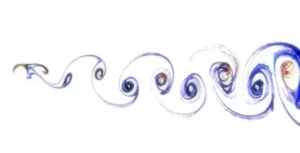Turbulent Model: The Starry Night Approach
It’s safe to say that Starry Night is one of the most recognized pieces of art in the modern era. It is an oil canvas painting by Dutch-Post Impressionist painter, Vincent Willem Van Gogh. He painted it while on his stay at the asylum of Saint-Paul-de-Mausole, near Saint-Rémy-de-Provence after mutilating his own ear! Though quite famous for the techniques (impasto) he used and the depiction of light from the moon and the stars in this painting, a quintessential trait lies beneath the ethereal beauty of the Starry Night; Turbulence.
Though science has the answer to seemingly everything, it fails to find a complete explanation on turbulence. A popular example of turbulence can be experienced on an airplane, when there’s a sudden jolt of vibration which seems to stem out of nowhere! Any one that has studied fluid mechanics is well acquainted with the unpredictability and beauty of turbulence. The primary factor governing any turbulent flow is the formation of eddies or vortices which are simply swirls of fluid formed when the fluid is in turbulent flow (as shown below).

Such swirls can also be observed in tornadoes and tycoons, most prominently on the big red spot in Jupiter.
“I am an old man now, and when I die and go to heaven, there are two matters on which I hope for enlightenment. One is quantum electrodynamics and the other is turbulent motion of fluids. About the former, I am really rather optimistic.”
Sir Horace Lamb
By using short and light brush strokes along with the use of contrasting colors and painting swirls or eddies to express the motion of light from the moon and stars, he was able to make the light flicker and radiate like most Impressionists of his time. In simple words, he was able to make the painting come alive. This is termed as luminance. In 2004, the Hubble’s Space Telescope discovered these very eddies of a distant cloud of dust and gas around a star which prompted scientists to refer to Van Gogh’s Starry Night. Thus began the wide research to study the luminance in Van Gogh’s paintings in detail.
The researchers digitized the paintings, and measured how brightness varies between any two pixels. From the curves measured for pixel separations, they concluded that paintings from Van Gogh’s period of psychotic agitation behave remarkably similar to fluid turbulence. However, other impressionist paintings of the time on inspection didn’t seem to correspond with the idea above (refer to “The Scream”, by Munch, Monet’s “Water Lilies” etc.) further adding to the genius of Vincent Van Gogh.
What’s more interesting is the fact that these turbulent patterns were not observed in paintings stemming from calmer periods of his life. To state that Vincent’s life was bumpy would be a major understatement. Plagued by psychiatric illness throughout his life, Van Gogh committed suicide in 1890. Evidence suggests that he had manic depression, a chronic mental illness thought affects many creative people.
Though it is quite difficult to express the deepest ideas of turbulence with math and science, Van Gogh, despite his mental trauma and intense suffering, and maybe unknowingly, was successful to perceive and represent one of the most supremely difficult concepts nature has ever brought before mankind.
